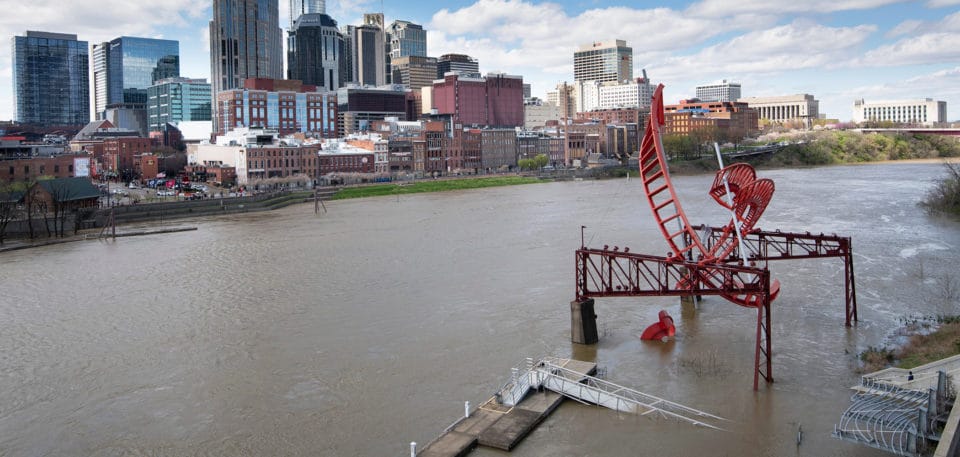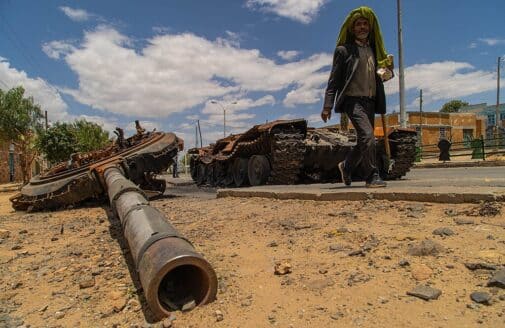Congressional Testimony: The Cost of Inaction on Climate Change

March 2021 flooding in Nashville, TN. Photo by George Walker IV / The Tennessean
On April 15, 2021, the US Senate Committee on the Budget heard from a panel of experts on The Cost of Inaction on Climate Change. Among those providing testimony was Dr. Robert Litterman, Chair of the Commodity Futures Trading Commission’s Climate-Related Market Risk Subcommittee and a member of Woodwell Climate’s Board of Directors. This is not Dr. Litterman’s first Congressional testimony on this topic. Last year, he testified before the House Special Committee on the Climate Crisis regarding the economic risks of climate change.
Below is his oral testimony to this week’s Senate Budget hearing:
Chairman Sanders, Ranking Member Graham, members of the committee. Thank you for inviting me to address the risks that climate change poses and my suggestions for how to deal with them. Climate change is real, and the risks that it imposes on our society are extraordinary. Though there are tremendous uncertainties about exactly how climate change will play out over time, that risk demands an immediate, ambitious, response.
My name is Bob Litterman. I am an economist by training and have spent my career managing financial risk. I chair the Commodity Futures Trading Commission Climate-Related Market Risk Subcommittee which published its report on Managing Climate Risk in the U.S. Financial System last fall. I worked at Goldman Sachs for 26 years, where I finished as a partner in 2009. I led the Firmwide Risk Management Department, and later managed the Quantitative Strategies Group in our Asset Management Division.
Financial risk management has several simple principles that apply to managing climate risk.
Most important, risk management requires imagining “worst case” scenarios. A risk manager’s job is not to just maximize returns, but to prevent extremely bad, but very plausible, scenarios. Identifying those scenarios is especially hard for climate risk because we are performing this experiment for the first time, it is irreversible, and the impacts will be felt for many decades to come. David Wallace Wells has done a commendable job illustrating the scientific research on worst-case scenarios.
Another principle of financial risk management, which is perhaps not as obvious, is that our objective is not to minimize risk, but to price risk appropriately. For example, at Goldman Sachs we placed a risk-based charge on traders to force them to take risks only where the firm would be more than compensated by the expected returns on their trades.
A third principle of risk management is that time is a scarce resource. If we have enough time, we can solve almost any problem. It is when time runs out that a risk breeds catastrophe. The risk from climate change is increasing as we fill the atmosphere with greenhouse gases. We do not know how much time we have before we cross a tipping point, after which the increased extent of such disasters becomes irreversible. This is an extremely urgent matter.
More colloquially, we are barreling toward a hazard of our own making, now we need to brake hard.
We must act decisively today so that, even in a worst-case climate scenario, the costs to society are manageable. These costs include: more extreme weather, sea level rise, wildfires, threats to national security from failed states and climate-induced mass emigration, and biodiversity loss. But addressing these effects will not reduce risk at the systemic level, when everything goes wrong.
For that we must reduce emissions and move rapidly to a net-zero emissions economy. The scale and urgency of that transformation require that financial markets immediately and dramatically increase the flow of capital toward investments that will reduce emissions. Then, we will almost surely need to follow that by removing significant quantities of greenhouse gases out of the atmosphere. Making those investments profitable and fostering the innovation necessary requires putting a price on carbon. Whether it is the National Academies of Sciences, the Business Roundtable, the American Petroleum Institute, or Nobel-winning economists like Professor Stiglitz—to cite some recent examples—experts and interested parties agree.
Congress needs to become the risk manager here. The most straightforward manner to price carbon is placing a tax on fossil fuel production. The risk management component of the carbon tax is the incentive it creates to reduce emissions; any revenues are available for other purposes.
The Climate Leadership Council, which I co-chair with Kathryn Murdoch, has developed the Baker-Schultz carbon dividend plan. There the revenues of a tax on fossil fuel producers would be returned directly to households. Several members of this committee have introduced carbon pricing legislation in the past or actively support it now. The exact policy construction varies between proposals, but there are other experts who can help Congress understand those policy questions and any resulting tradeoffs. I recognize that there are a variety of opinions about carbon pricing and their design, but leadership and compromise can help build strong coalitions of support.
To manage climate risks, the key would be to create a price immediately, set it high enough to reflect the risks imposed by greenhouse gas emissions, and apply it to emissions across the entire economy.
I and my colleagues stand ready to help you deliberate between these policies and do what is best for Americans and the future. Thank you.








